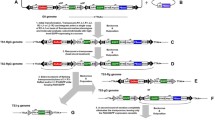Abstract
Electroporation conditions have been standardized for the mass mobilization of foreign DNA into silkworm eggs. The hatchability of egg varied depending upon the electroporatic conditions. The maximum hatchability of 68% was at the electroporatic condition of 200V/cm and 25μF with two pulses. Electroporation has resulted in successful transfer of foreign DNA into silkworm eggs and it has been confirmed by slot blot, Southern blot and PCR analysis. © Rapid Science Ltd. 1998
Similar content being viewed by others
References
Andreason, GL and Evans, GL (1988). Biotechniques 6: 650-660.
Gorman, CM, Moffat, LF and Howard, BH (1982). Mol. Cell. Biol. 2: 1044-1051.
Jowett, T (1986). Preparation of Nucleic acid In: Drosophila, A Practical Approach, DB Roberts ed. pp. 275-286 Oxford: IRL Press.
Kamdar, P, Von Allmen, G, and Finnerty, V (1992). Nucl. Acids Res. 20: 3526-3526.
Krishnaswami, S (1978). New Technology of Silkworm Rearing, Mysore (India): CSRTI.
Leopold, RA, Hughes, KJ and DeVault, JD (1996). Genet. Anal. Biomol. Eng. 12: 197-200.
Okada, K, Nagata, T and Takebe, I (1986). Plant Cell Physiol., 27: 619-629.
Orlowski, S and Mir, LM (1993). Biochim. Biophys. Acta. 1154: 51-63.
Sambrook, J, Fritsch, EF and Maniatis, T (1989). Molecular Cloning: A Laboratory Manual, New York: Cold Spring Harbor Laboratory.
Shamila, Y and Mathavan, S (1996). Indian J. Seric. 35: 80-82.
Shamila, Y and Mathavan S (1998). Arch. Insect Biochem. Physiol. 37: 168-177.
Tamura, T, Kanda, T, Takiya, S, Okano, K and Maekawa, H (1990). Jpn. J. Genet. 65: 401-410.
Tsai, HJ and Tseng FS (1994). Fish. Sci. 60: 787-788.
Weaver, JC (1995). Electroporation: Theory concepts and mechanisms. Electroporation protocols for microorganisms In: Methods in Molecular BiologyJ.A. Nickoloff ed. Vol. 47 pp 1-26, New Jersey: Totowa Humana Press Inc.
Xie, Y, Liu, D, Zou, J, Li, G and Zhu, Z (1993). Aquaculture 111: 207-213.
Rights and permissions
About this article
Cite this article
Shamila, Y., Mathavan, S. Gene transfer in silkworm Bombyx mori via electroporation. Biotechnology Techniques 12, 507–510 (1998). https://doi.org/10.1023/A:1008891111905
Issue Date:
DOI: https://doi.org/10.1023/A:1008891111905




